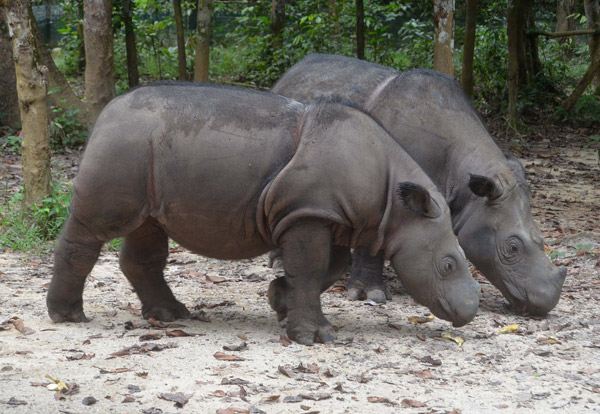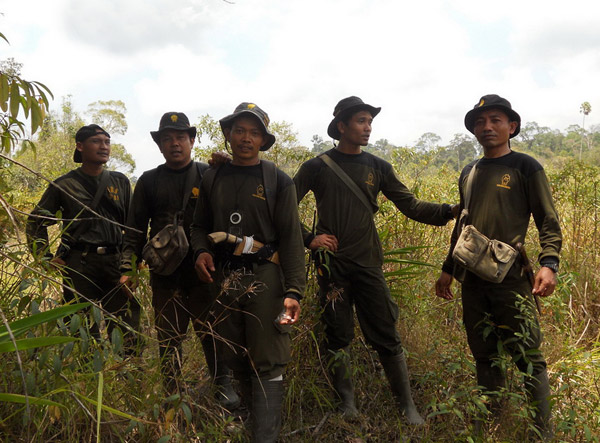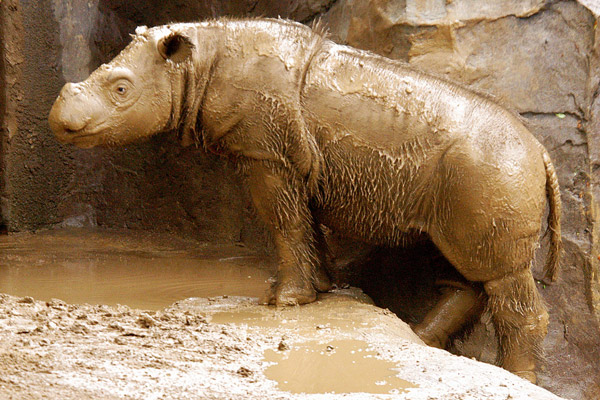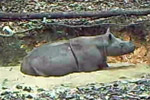
Bina (female) and Andalas (male) meet at the Sumatran Rhino Sanctuary. Photo by: Dedi Candra.
In 1893, William Bell, a surgeon in the service of the Dutch East India Company stationed in Bencoolen, Sumatra, examined the body of a dead rhinoceros. The animal, a male, was relatively small as rhinoceroses go, measuring only four feet four inches at the shoulder and eight feet five inches from its nose to the tip of its tail. Dr. Bell noted that the animal resembled a large hog and judged it to be a young individual based upon the condition of the bones and teeth.
“There were six molares, or grinders, on each side of the lower jaw. The tongue was quite smooth. The ears were small and pointed, lined and edged with short black hair, and situated like those of the single horned rhinoceros. The horns were black, the larger placed immediately above the nose, pointing upwards…; it was about nine inches long. The small horn was four inches long …standing in line with the larger horn, immediately above it. They were both firmly attached to the skull, nor was there any appearance of joint, or muscles to move them,” Bell wrote. “The whole skin of the animal is rough, and covered very thinly with short black hair… The animal had not the appearance of armour which is observed in the single horned rhinoceros.”
The single-horned creature to which Dr. Bell compared the specimen was the greater one-horned or Indian rhinoceros, christened Rhinoceros unicornis by the eminent taxonomist, Carolus Linnaeus, in 1758. It’s not clear if Dr. Bell was aware of the other one-horned species that still inhabited the island of Sumatra at that time. Marco Polo may have observed it early in the 14th century, writing in his journal of the “monoceros”. Sumatra’s “other rhino” was the last of the living species recognized by the scientific community, officially described as the lesser one-horned or Javan rhinoceros (Rhinoceros sondaicus) in 1822. Just over a century later, probably in the 1930s, it was extirpated—wiped out—from the Sumatra, the world’s fifth largest island, though it still survives today in a small population on Java.

Male, Harapan, born at the Cincinnati Zoo in 2007. Sumatran rhinos are the hairiest of the world’s rhino species. Photo courtesy of Bill Konstant.
It wasn’t until 1814, nearly two decades after Dr. Bell’s anatomical examination, that German biologist Johann Gotthelf Fischer von Waldheim, provided a scientific description of the Asian two-horned or Sumatran rhinoceros (Dicerorhinus sumatrensis). At the time, the species could be found from as far away as Assam in northeastern India, south through mainland Asia and peninsular Malaysia, onto the islands of Borneo and Sumatra. Three subspecies were ultimately recognized, lasiotis in the north, harrisoni on the island of Borneo, and sumatrensis in Peninsula Malaysia and on Sumatra. The species probably once numbered in the tens of thousands across these countries, but centuries of hunting and habitat loss drastically reduced its populations to small fragments. The northern subspecies, lasiotis, is now extinct. There’s a chance that some animals may survive on mainland Asia, but certainly any relict populations cannot be considered viable, including the few animals that somehow have managed to hang on by a thread in Borneo.
The final stronghold for the critically endangered Sumatran rhino is the island from which it derives its name. Experts now believe that about 100 animals survive in three Indonesian national parks: Bukit Barisan Selatan, Gunung Leuser and Way Kambas. Today, the International Rhino Foundation (IRF), working in collaboration with its Indonesian NGO partner, Yayasan Badak Indonesia (YABI), and national authorities, provides anti-poaching patrols in both Bukit Barisan Selatan and Way Kambas National Parks. Specially-trained Rhino Protection Units (RPUs) assist government forest guards by conducting round-the-clock surveillance, as well as monitoring populations of Sumatran rhino, elephant, tiger and tapir. Seven four-man RPUs patrol Bukit Barisan Selatan and five units are stationed in Way Kambas, a total of 48 well-trained professionals safeguarding elusive rhinos that barely outnumber them. Though the park guards and rangers cover thousands of kilometers each year on patrol, the number of times they directly observe Sumatran rhinos in the wild can easily be counted on only one or two hands. They confirm the presence of survivors through indirect evidence – footprints, dung, wallows and plants that have been fed upon. Measurements are routinely taken and samples collected for further scientific investigation, allowing experts to estimate population densities and composition. Thanks to the protection afforded by the RPU program, the last documented incident of a Sumatran rhino being killed by poachers took place in Way Kambas National Park in 2006. Support for this crucial effort comes from a funding consortium that includes a variety of government, foundation and private sources, including annual Bowling for Rhinos fundraising events held by the American Association of Zookeepers.

Full body illustration of Sumatran rhino. Illustration by: William Bell 1793.
In addition to the remaining wild Sumatran rhinos, nearly another ten rhinos are currently maintained in three managed breeding centers: five at the Sumatran Rhino Sanctuary in Way Kambas National Park, three at the Borneo Rhino Sanctuary in Sabah, Malaysia, and two at the Cincinnati Zoo in the United States. Four Sumatran rhinos have been born in captivity thus far this century, the first three in Cincinnati. The first one, Andalas, was born in September 2001. As part of an international commitment to the species, he was sent to Indonesia, where he mated with a wild-caught female, Ratu, and fathered a male calf, Andatu—the first Sumatran rhino born in captivity in its native Indonesia. Andatu’s birth has helped focus attention on the plight of this Critically Endangered species. Just a few weeks prior to Andatu’s arrival, Indonesia’s president launched the International Year of the Rhino. In March 2013, rhino specialists from around the world convened in Singapore for a Sumatran Rhino Crisis Summit and, only a few months ago, the first meeting of Asian Rhino Range States, held in Bandar Lampung, called for expanded protection efforts on behalf of Sumatran, Javan and Indian rhinos.
The New Year marks the bicentennial anniversary of the Sumatran rhino being described by science. A species that appeared on Earth millions of years ago now battles for its very survival. Protection efforts that have proven successful must not only continue, but be expanded. If we do this, 2014 will mark the beginning of the Sumatran rhino’s recovery. Should we fail to mobilize, the years ahead will simply bring us closer to its requiem.

Andatu (one year old) and his mother, Ratu, at the Sumatran Rhino Sanctuary. Photo by: Bill Konstant.

Rhino Protection Unit in Way Kambas National Park. Photo courtesy of YABI.

Skull of the Sumatran rhino. Illustration by: William Bell, 1793.

Harapan. Photo courtesy of Bill Konstant.
Related articles
WWF risking Sumatran rhinos by releasing camera trap images, says scientist

(10/09/2013) On October 2nd, WWF released camera trap videos of Sumatran rhinos surviving in Kalimantan, Indonesian Borneo. The conservation organization had already announced in April that they had evidence of at least one Sumatran rhino in the province, but the new images confirmed what is likely to be a small surviving population. While this is good news for an animal on the edge of extinction, Erik Meijaard, a researcher who has worked in Indonesia for over 20 years, says WWF has made a mistake publicizing the news around the world, noting ‘the last thing those rhinos need is publicity.’
Worst rhino poaching year on record for South Africa
(09/29/2013) At least 688 rhinos have been poached in South Africa this year, surpassing last year’s record of 668 with more than three months remaining in 2013, reports the country’s top environmental official.
The Javan Rhino’s final stronghold

(07/29/2013) August 27, 1883. It’s been called ‘the day the world exploded’. One hundred and thirty years ago this month, the volcanic island of Krakatau (Krakatoa) blew its top. The smoking mountain had given several days warning to the human inhabitants of Java and Sumatra, the closest large islands, but no one could have imagined the intensity of the eruption and the devastation that followed. Several cubic miles of rock and ash – more than half the island – rocketed skyward. The explosion released over 10,000 times the energy of the atomic bomb dropped on Hiroshima and was an order of magnitude more powerful than the eruption of Mount St. Helens. Tsunamis greater than 100 feet high roared over coastal habitats, inundating lowland forests and scouring them of wildlife.
Tigers, orangutans, rhinos: Sumatra’s big mammals on the edge of extinction
(06/12/2013) Karman Lubis’s body was found near where he had been working on a Sumatran rubber plantation. His head was found several days later a mile away and they still haven’t found his right hand. He had been mauled by a Sumatran tiger that has been living in Batang Gadis National Park and he was one of five people killed there by tigers in the last five years.
Rhino populations in Sumatra, Borneo should be combined to save Sumatran rhino from extinction

(05/15/2013) A new study argues for treating endangered Sumatran populations in Borneo and Sumatra as ‘a single conservation unit’, lending academic support to a controversial proposal to move wild rhinos from Malaysia to Indonesia.
Malaysia may loan Indonesia rhinos to save species from extinction

(04/30/2013) Conservationists and officials meeting last month at a rhino crisis summit in Singapore agreed to a radical plan to loan Sumatran rhinos between nations if it means saving the critically endangered species from extinction. The proposal, which could still be thwarted by red tape and political opposition, could lead Malaysia to send some of its Sumatran rhinos to semi-captive breeding facilities in Indonesia.